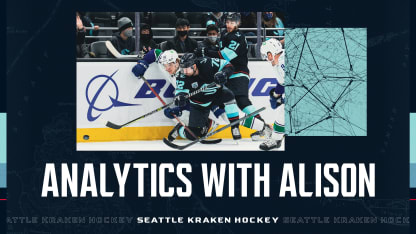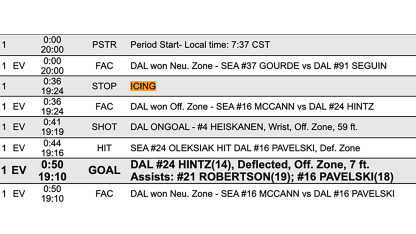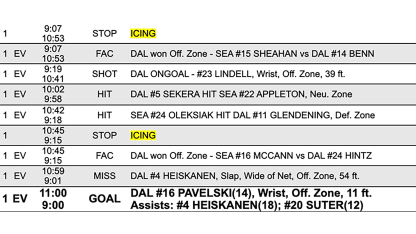Tomlinson and I got to talking. "I've never seen such blatant examples of (a goal coming off an icing)," he said.
So, is committing an icing really that dangerous or that much of a threat to your team?
Let's dig in.
Sportlogiq (with a special stick tap to Nick Czuzoj-Shulman) ran data on eight seasons of games and here's what they found (all data represents 5-on-5 play).
FACEOFF WINS:
GOALS AFTER AN OFFENSIVE ZONE FACEOFF WIN (Immediate possession following):
So, it doesn't look like there is that much impact on goal scoring after an icing. As an example, there were 66 faceoffs in the Seattle-Dallas game. If we apply the average win rate of 47.11%, the difference in goal scoring if all of these faceoffs came off an icing versus in normal play is .06 goals.
But, (our gut says) icing feels like a desperation move when players are tired or not connecting on a play, does it matter how long skaters were on the ice before the icing occurred? After all, if players were already tired, surely they're going to be fatigued as they must stay on the ice for the ensuing faceoff.
According to Sportlogiq, the average shift length for defensive players prior to a faceoff in a team's own zone is 13.6 seconds. This does go up to 31.8 seconds prior to an icing, but, there's not much differential when it comes to any resulting goal scoring. The only real area where shift length starts to give attacking teams a real advantage is when the defending team has shift lengths of 60 seconds or more, and, yeah, that makes sense.
Ultimately, understanding what makes icings more dangerous is understanding what truly makes an impact. It's not necessarily about the fatigue of the defending team, it's more about setting up your opponent to pick who and on which side they want to take a faceoff (which also often puts defensive teams on a sub-optimal side for faceoffs).
This is something Tomlinson had sniffed out already as part of his original thought process.
"The new rule about picking which faceoff dot after an icing is excellent," Tomlinson said. "Traditionally great faceoff teams are probably licking their chops (at an icing opportunity) … but my gut tells me you should be able to get the puck out of the zone (without worrying too much about icing)."
Knowing what we now know, let's circle back to the Dallas game to feel what the impact really is of an icing (at least in this game).
Yes, of course those two goals sting. No negating that. But there were 16 icings in the game across both teams. Five by Seattle, and 11 by Dallas. Of those 16, two gave way to goals, even though both teams lost more faceoffs than they won after icing the puck (Seattle won 1, lost 4; Dallas won five lost six).
At the end of the day, as Sportlogiq's Kenny Matheson said, icing the puck may give your opponent a small advantage, and specific circumstances (faceoff specialists; total volume of faceoffs/icings, etc.) may make icings more costly, but their impact is not truly significant to the overall outcome of the game.
It's those special circumstances that invite the impact of coaching, pre-scouting and deployment to take advantage of any situational play.
"Stuff gets drilled into our head by coaches and we don't question if it's actually what will or will not happen," Tomlinson said. "When I think about the game, I try to think 'if I was a coach, what would I want my team to do?'"





